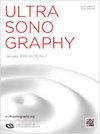脉冲聚焦超声诱导声流效应评价溶质对多孔介质的平流渗透
IF 2.4
3区 医学
Q2 RADIOLOGY, NUCLEAR MEDICINE & MEDICAL IMAGING
引用次数: 0
摘要
本文章由计算机程序翻译,如有差异,请以英文原文为准。
Evaluation of advective solute infiltration to porous media by pulsed focused ultrasound-induced acoustic streaming effects
PURPOSE
Acoustic streaming induced by applying transcranial focused ultrasound (FUS) promotes localized advective solute transport in the brain and has recently garnered research interest for drug delivery and enhancement of brain waste clearance. The acoustic streaming behavior in brain tissue is difficult to model numerically and thus warrants an in vitro examination of the effects of using different sonication parameters, in terms of frequency, intensity, and pulse duration (PD).
METHODS
Melamine and polyvinyl alcohol (PVA) foams were used to mimic the porous brain tissue, which contains leptomeningeal fenestrations and perivascular space, while agar hydrogel was used to emulate denser neuropil. FUS was delivered to these media, which were immersed in a phosphate-buffered saline containing toluidine blue O dye, across various frequencies (400, 500, and 600 kHz; applicable to transcranial delivery) in a pulsed mode at two different spatialpeak pulse-average intensities (3 and 4 W/cm2).
RESULTS
Image analysis showed that the use of 400 kHz yielded the greatest dye infiltration in melamine foam, while sonication had no impact on infiltration in the agar hydrogel due to the dominance of diffusional transport. Using a fixed spatial-peak temporal-average intensity of 0.4 W/cm2 at 400 kHz, a PD of 75 ms resulted in the greatest infiltration depth in both melamine and PVA foams among the tested range (50-150 ms).
CONCLUSION
These findings suggest the existence of a specific frequency and PD that induce greater enhancement of solute/fluid movement, which may contribute to eventual in vivo applications in promoting waste clearance from the brain.
求助全文
通过发布文献求助,成功后即可免费获取论文全文。
去求助
来源期刊

Ultrasonography
Medicine-Radiology, Nuclear Medicine and Imaging
CiteScore
5.10
自引率
6.50%
发文量
78
审稿时长
15 weeks
期刊介绍:
Ultrasonography, the official English-language journal of the Korean Society of Ultrasound in Medicine (KSUM), is an international peer-reviewed academic journal dedicated to practice, research, technology, and education dealing with medical ultrasound. It is renamed from the Journal of Korean Society of Ultrasound in Medicine in January 2014, and published four times per year: January 1, April 1, July 1, and October 1. Original articles, technical notes, topical reviews, perspectives, pictorial essays, and timely editorial materials are published in Ultrasonography covering state-of-the-art content.
Ultrasonography aims to provide updated information on new diagnostic concepts and technical developments, including experimental animal studies using new equipment in addition to well-designed reviews of contemporary issues in patient care. Along with running KSUM Open, the annual international congress of KSUM, Ultrasonography also serves as a medium for cooperation among physicians and specialists from around the world who are focusing on various ultrasound technology and disease problems and relevant basic science.
 求助内容:
求助内容: 应助结果提醒方式:
应助结果提醒方式:


